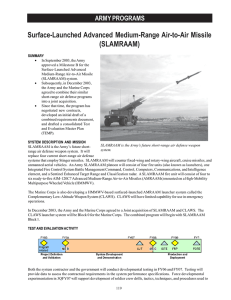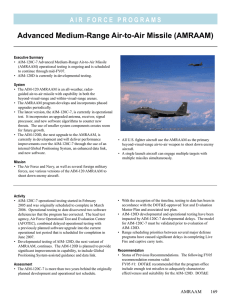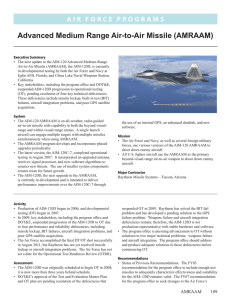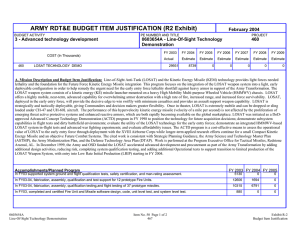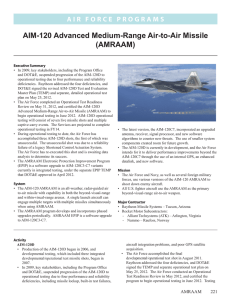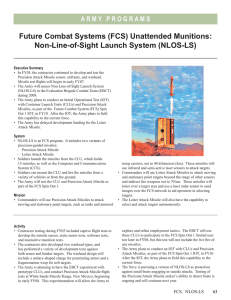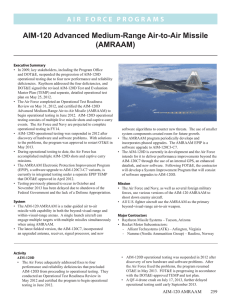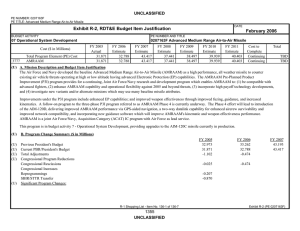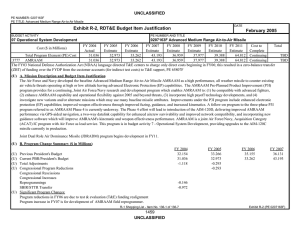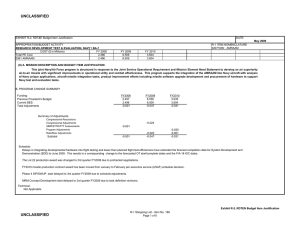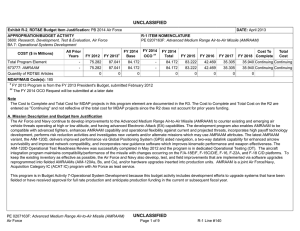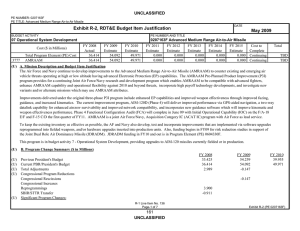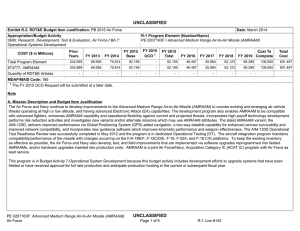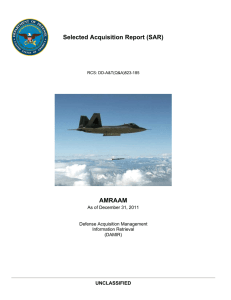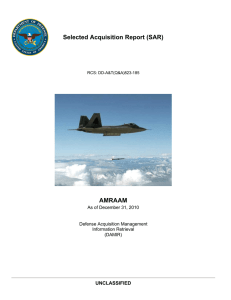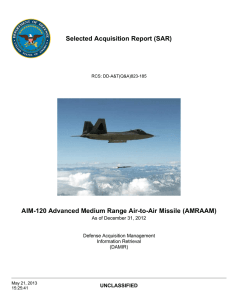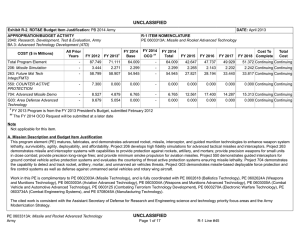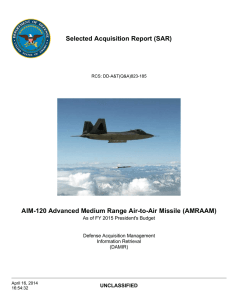T Surface-Launched Advanced Medium Range Air-to-Air Missile (SLAMRAAM) ARMY PROGRAMS
advertisement
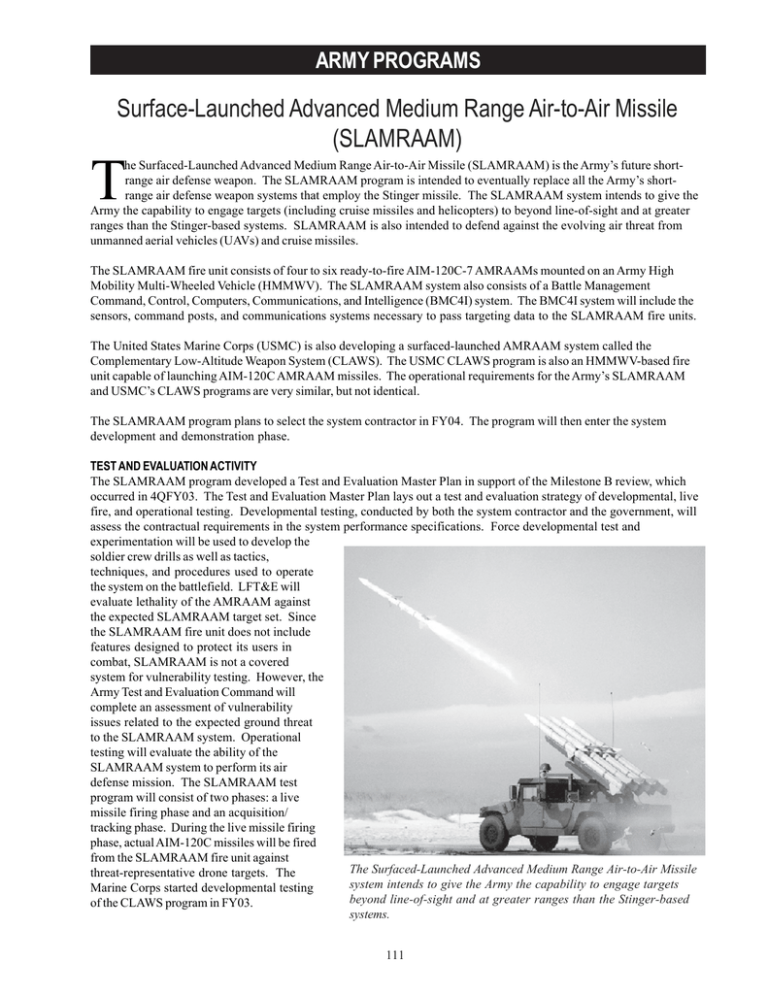
ARMY PROGRAMS Surface-Launched Advanced Medium Range Air-to-Air Missile (SLAMRAAM) T he Surfaced-Launched Advanced Medium Range Air-to-Air Missile (SLAMRAAM) is the Army’s future shortrange air defense weapon. The SLAMRAAM program is intended to eventually replace all the Army’s shortrange air defense weapon systems that employ the Stinger missile. The SLAMRAAM system intends to give the Army the capability to engage targets (including cruise missiles and helicopters) to beyond line-of-sight and at greater ranges than the Stinger-based systems. SLAMRAAM is also intended to defend against the evolving air threat from unmanned aerial vehicles (UAVs) and cruise missiles. The SLAMRAAM fire unit consists of four to six ready-to-fire AIM-120C-7 AMRAAMs mounted on an Army High Mobility Multi-Wheeled Vehicle (HMMWV). The SLAMRAAM system also consists of a Battle Management Command, Control, Computers, Communications, and Intelligence (BMC4I) system. The BMC4I system will include the sensors, command posts, and communications systems necessary to pass targeting data to the SLAMRAAM fire units. The United States Marine Corps (USMC) is also developing a surfaced-launched AMRAAM system called the Complementary Low-Altitude Weapon System (CLAWS). The USMC CLAWS program is also an HMMWV-based fire unit capable of launching AIM-120C AMRAAM missiles. The operational requirements for the Army’s SLAMRAAM and USMC’s CLAWS programs are very similar, but not identical. The SLAMRAAM program plans to select the system contractor in FY04. The program will then enter the system development and demonstration phase. TEST AND EVALUATION ACTIVITY The SLAMRAAM program developed a Test and Evaluation Master Plan in support of the Milestone B review, which occurred in 4QFY03. The Test and Evaluation Master Plan lays out a test and evaluation strategy of developmental, live fire, and operational testing. Developmental testing, conducted by both the system contractor and the government, will assess the contractual requirements in the system performance specifications. Force developmental test and experimentation will be used to develop the soldier crew drills as well as tactics, techniques, and procedures used to operate the system on the battlefield. LFT&E will evaluate lethality of the AMRAAM against the expected SLAMRAAM target set. Since the SLAMRAAM fire unit does not include features designed to protect its users in combat, SLAMRAAM is not a covered system for vulnerability testing. However, the Army Test and Evaluation Command will complete an assessment of vulnerability issues related to the expected ground threat to the SLAMRAAM system. Operational testing will evaluate the ability of the SLAMRAAM system to perform its air defense mission. The SLAMRAAM test program will consist of two phases: a live missile firing phase and an acquisition/ tracking phase. During the live missile firing phase, actual AIM-120C missiles will be fired from the SLAMRAAM fire unit against The Surfaced-Launched Advanced Medium Range Air-to-Air Missile threat-representative drone targets. The system intends to give the Army the capability to engage targets Marine Corps started developmental testing beyond line-of-sight and at greater ranges than the Stinger-based of the CLAWS program in FY03. systems. 111 ARMY PROGRAMS The LFT&E strategy will build upon previous lethality testing and live missile firings, and will use modeling and simulation to assess lethality against the expanded target set. Most of the expanded target set vulnerable areas have been characterized and confirmed through previous modeling and testing. Modeling and analysis will determine new target vulnerabilities to SLAMRAAM. Lethality against these targets will be determined using validated and accredited AMRAAM models. This two-year effort will begin in 1QFY04 and complete in 1QFY06. TEST AND EVALUATION ASSESSMENT Two issues are critical to an adequate assessment of the operational effectiveness and suitability of the SLAMRAAM program. The first issue is the ability of the AIM-120C AMRAAM missile to perform against the targets of interest to the Army, namely, UAVs, cruise missiles, and helicopters. Firings against these types of targets have not been done throughout the long history of the AMRAAM test program conducted by the Air Force and Navy. Second, the integration of the BMC4I is critical to the success of SLAMRAAM. The SLAMRAAM system, unlike the Stinger-based weapons, cannot autonomously engage targets. The SLAMRAAM fire unit must receive targeting data from the BMC4I system, including targeting data acquired from sensors operated by other Services. The BMC4I system must also provide target identification of friendly aircraft. This becomes critical since SLAMRAAM provides a beyond line-of-sight engagement capability that cannot rely on visual identification means to distinguish friendly aircraft from enemy threats. The BMC4I system must also be mobile enough to keep up with rapidly advancing maneuver forces. 112
